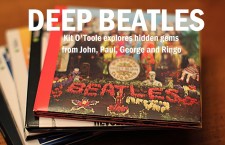It’s always risky to mess with the rock ‘n’ roll legacy of those Fab Four lads from Liverpool known to the world as the Beatles. Their essential history has been researched and discussed in such depth that it becomes more legend than story with every telling. Consequently, it blurs not only the line between fact and fiction, but also the demarcation points that differentiate fans, critics and historians.
This is partly because the telling of the Beatles’ tale is so detailed, complicated and open to interpretation. For instance, the breakup of the Beatles was discussed amongst the group in 1969, announced to the public in 1970 amidst controversy regarding the closeness of the release of Paul McCartney’s first solo album to that of Let It Be, and made official legally by the British High Court in 1975.
The complexity attached to such a seemingly simple question as “When did the band break up?” extends itself into many other aspects of the Beatles’ mythos, including the question of just what qualifies as a Beatles’ album. One could debate all sorts of points, including: UK or U.S. version; LP or CD; stereo or mono; mix or remix. One could even ask if a compilation counts not just as a compilation of songs, but as an album in and of itself. For instance, consider the releases 1963-1966 and 1967-1970 (informally called The Red Album and The Blue Album, respectively). These have each sold many more copies than some of the Beatles’ official album releases, so if sales count for anything, it’s possible that many people might cite these as their personal Beatles’ album listening preferences.
One selling point of the albums was that they collected all the A-side singles and shored them up with some choice album cuts. Even then, the Beatles had so many good tracks, which do you leave out? Take this example from The Red Album: Yes, it was a successful single, but why is the last song on the record “Yellow Submarine” when there were so many better songs to choose from on Revolver and elsewhere? In fact, the Beatles released well over 100 songs between 1962 and 1966, so collecting 26 of them ignores three-quarters of their catalogue from that time period.
Of course, one can always track down those missing gems and lesser lights, and through the use of modern playlist technology, they might be presented as a parallel companion to The Red Album. Of course, it would have to be called …
I Saw Her Standing There
There’s a Place
Twist and Shout
It Won’t Be Long
Don’t Bother Me
Money (That’s What I Want)
I’ll Get You
I Should Have Known Better
Things We Said Today
You Can’t Do That
I’ll Be Back
No Reply
Every Little Thing
I Don’t Want to Spoil the Party
What You’re Doing
I’m Down
It’s Only Love
I’ve Just Seen a Face
You Won’t See Me
I’m Looking Through You
If I Needed Someone
Rain
Taxman
I’m Only Sleeping
She Said She Said
And Your Bird Can Sing
Got to Get You Into My Life
Tomorrow Never Knows
None of these tracks are too difficult to find these days. “There’s a Place” and “Every Little Thing” were left off U.S. album pressings back in the ‘60s, but are on the currently in-print CDs, which follow the original UK running orders. The cover versions of “Twist and Shout” and “Money (That’s What I Want)” are essential Beatles’ performances, and should have made the original cut. “Rain” and “I’m Down” are some great B-side inclusions. This playlist compilation also corrects the lack of George Harrison songwriting contributions by including three of his compositions. And how could any early Beatles’ collection omit “I Saw Her Standing There” and pretend to be complete?
Yes indeed, the Beatles’ deserved every bit of early success they got. After all, they had a lot of good material. How much? Even after twice harvesting the best of the best, there are still enough tunes to run up a third set of a couple of dozen or so great Beatles’ tunes from this era.
Such is the nature of mythology: that which appears simple connects in different ways until the story reveals that the legend was there in the making all along — in this case, one song at a time.
- How David Bowie’s ‘The Next Day’ Stripped Away All of the Artifice - March 15, 2023
- Why Deep Purple’s ‘Who Do We Think We Are?’ Deserves Another Listen - January 11, 2023
- In Defense of the Often-Overlooked Mott the Hoople - November 10, 2022


